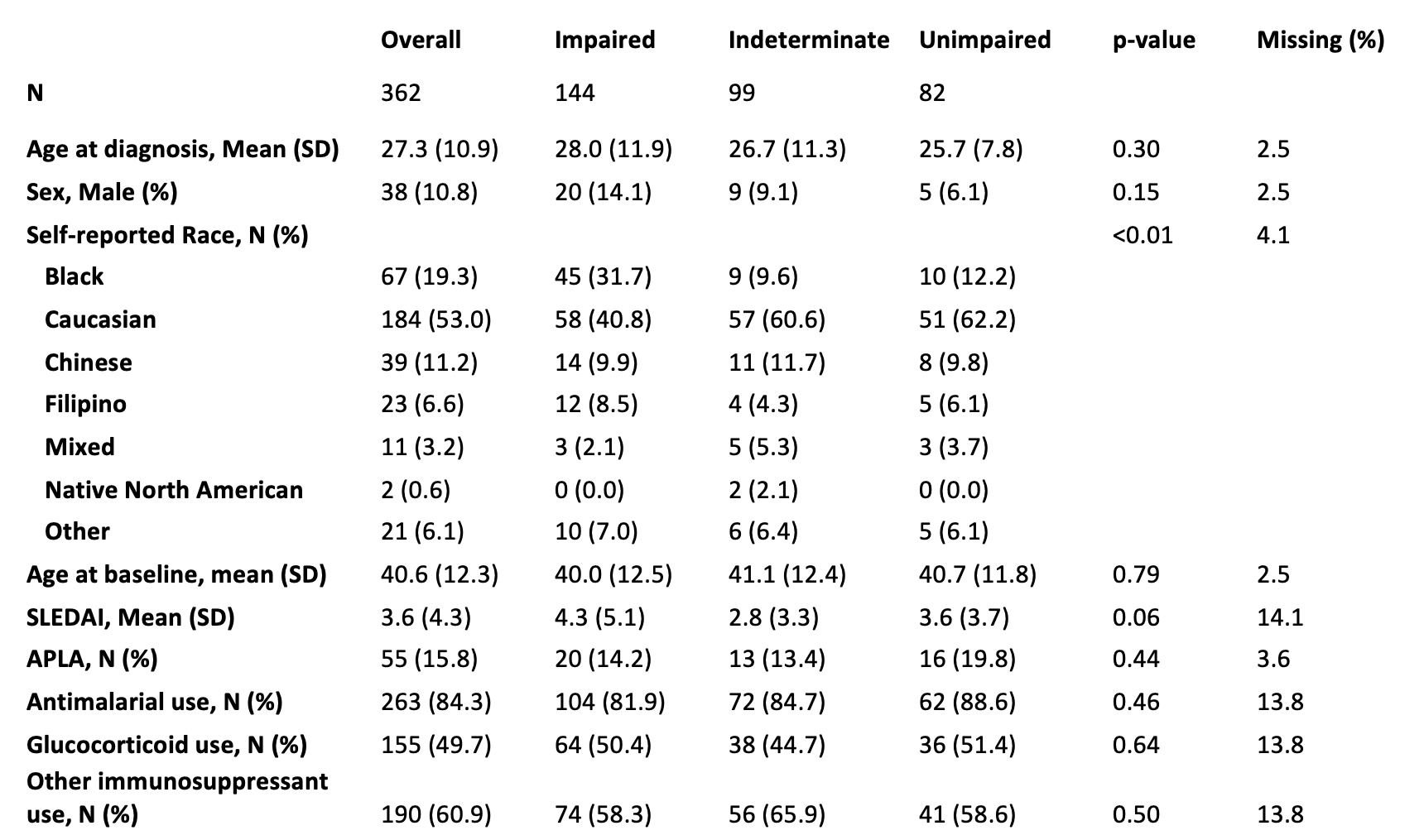Session Information
Session Type: Poster Session B
Session Time: 10:30AM-12:30PM
Background/Purpose: Systemic lupus (SLE) has a well-established association with cognitive impairment (CI) and confers worse quality of life. We previously presented descriptive data regarding the prevalence and characteristics of CI in an inception lupus cohort in 20191. Here, we present expanded, updated prevalence and domain involvement, along with variations in clinical characteristics in those with CI versus those without.
Methods: Patients with SLE between the ages of 18 and 65 years were recruited from a single center from July 2016 to May 2024. Each consenting patient completed the American College of Rheumatology (ACR) neuropsychological battery (NB), and clinical and demographic information was gathered. The NB measures six key domains of cognition. Both in-person and virtual NB were administered. Raw NB scores were compared to age- and sex-matched normative data. Participants were classified as having CI using two definitions: 1) z-score of ≤-1.5 in two or more cognitive domains, or 2) z-score of ≤-2 in two or more cognitive domains. Participants were classified as having ‘indeterminate cognition’ if they had z-scores in only one domain meeting the above cut offs and as having ‘normal cognition’ if no scores met these cutoffs.
Results: 362 participants were enrolled. Mean age was 40.6 years and 38 (10.8%) were male. White participants were more likely to be unimpaired (Table 1). Demographic profiles were otherwise similar between groups. Prevalence of CI was n=144/362 (44.3%) based on Definition 1, and n=96/362 (30.1%) based on Definition 2. Prior data showed similar results, n=118/279, (42.3%, Definition 1). Definition 2 has been updated and no direct comparison is feasible (previously defined CI as z-score of ≤-2 in one or more domain). We have now also excluded motor speed and dexterity as data was not missing at random (high prevalence of arthritis or joint damage in our cohort leading to missing data in these patients).
Prior data also revealed that the most commonly affected domains were learning and memory (n=147/279, 44.1%) and visual spatial construction (n=94/279, 33.3%) (Definition 1). Current data show that visual spatial construction is most frequently impaired at n=193/362, 51.7% (Definition 1); n=150/362, 39.4% (Definition 2). Learning and memory was also frequently impaired n=130/362 (34.1% (Definition 1); n=93/362, 23.6% (Definition 2). Verbal fluency and executive function were infrequently affected (Figure 1).
Conclusion: In this cohort of 362 patients, the prevalence of SLE-CI has remained stable over the past five years, reaching 44%. The most frequently affected cognitive domains remain visual spatial function, and learning and memory. Further studies are ongoing to determine underlying pathogenesis and treatment for this challenging and complex complication of SLE.
1Moghaddam B et al. Prevalence of Cognitive Impairment in an Inception Lupus Cohort as Assessed by a Comprehensive Neuropsychological Battery [abstract]. Arthritis Rheumatol. 2019; 71 (suppl 10).
z-score ≤_1.5 (left); z-score ≤_2 (right).
Global: Impaired cognition = two or more domains impaired; Indeterminate = one domain impaired; Unimpaired = does not meet above criteria.
Domain 2, Simple attention and processing.
Domain 3, Visual spatial construction.
Domain 4, Verbal fluency.
Domain 5, Verbal and visuospatial learning and memory.
Domain 6, Executive function.
Impaired cognition, two or more domains with z-scores of ≤_1.5.
Indeterminate, one domain with z-score of ≤_1.5.
Unimpaired, does not meet prior criteria.
SLEDAI, Systemic lupus erythematosus disease activity index.
APLA, antiphospholipid antibodies present.
To cite this abstract in AMA style:
Dobrowolski C, Diaz Martinez J, Bingham K, Barraclough M, Kretzmann R, Tartaglia M, Ruttan L, Choi M, Appenzeller S, Marzouk S, Bonilla D, Katz P, Beaton D, Green R, Wither J, Whittall Garcia L, Gladman D, Touma Z. Cognitive Impairment Prevalence and Most Affected Domains in Patients with SLE by the ACR Comprehensive Neuropsychological Battery [abstract]. Arthritis Rheumatol. 2024; 76 (suppl 9). https://acrabstracts.org/abstract/cognitive-impairment-prevalence-and-most-affected-domains-in-patients-with-sle-by-the-acr-comprehensive-neuropsychological-battery/. Accessed .« Back to ACR Convergence 2024
ACR Meeting Abstracts - https://acrabstracts.org/abstract/cognitive-impairment-prevalence-and-most-affected-domains-in-patients-with-sle-by-the-acr-comprehensive-neuropsychological-battery/


